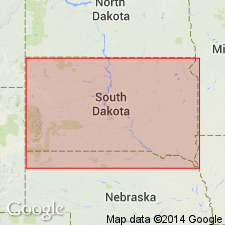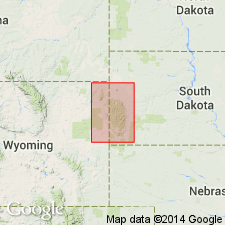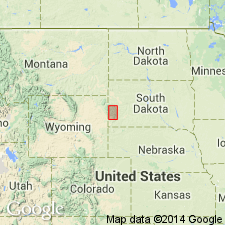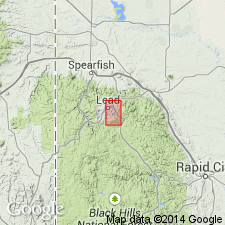
- Usage in publication:
-
- Ellison formation
- Modifications:
-
- Original reference
- Dominant lithology:
-
- Quartzite
- Schist
- AAPG geologic province:
-
- Midcontinent region
Summary:
Pg. 793-799, 836-843, with maps. Ellison formation. Massive, hard, medium-grained quartzites, usually in beds between 10 and 30 feet thick, interbedded with gray quartz mica (mostly muscovite) schist; these are overlain by a garnetiferous chloritic mica schist. Thickness 300 feet. Underlies West Ledge formation and overlies Homestake formation. Age is Precambrian. Believed to be Keewatin age (Archean). Report includes geologic map.
Named from exposures on road to Homestake Mine office and Ellison shaft, Lead district, Lawrence Co., southwestern SD.
Source: US geologic names lexicon (USGS Bull. 896, p. 676); supplemental information from GNU records (USGS DDS-6; Denver GNULEX).

- Usage in publication:
-
- Ellison Formation*
- Modifications:
-
- Age modified
- Overview
- AAPG geologic province:
-
- Midcontinent region
Summary:
Is mapped with Early Proterozoic quartzite (Xq, Pl. 1) in the Lead area, Lawrence Co, SD in the Midcontinent region. Overlies the Homestake Formation. Thought to be a correlative of the Buck Mountain Formation of the Nemo area, Lawrence Co, SD. Geologic map.
Source: GNU records (USGS DDS-6; Denver GNULEX).

- Usage in publication:
-
- Ellison Formation*
- Modifications:
-
- Geochronologic dating
- AAPG geologic province:
-
- Midcontinent region
Summary:
Tuffaceous sedimentary rock within the Ellison Formation is 1.97 +/-0.01 Ga (U-Th-Pb zircon) in the Lead area, SD in the Midcontinent region.
Source: GNU records (USGS DDS-6; Denver GNULEX).

- Usage in publication:
-
- Ellison Formation*
- Modifications:
-
- Overview
- Dominant lithology:
-
- Quartzite
- Schist
- Phyllite
- Amphibolite
- AAPG geologic province:
-
- Midcontinent region
Summary:
Consists of phyllite, quartz-mica schist, and quartzite. These lithologies are intermixed at the mine. Thickness at mine does not exceed 400 m. The quartzite is fine grained, gray, massive to faintly bedded, moderately well sorted with well-rounded grains. Most of the quartzite is impure; it contains sericite, biotite, and plagioclase. The quartzite is probably a subarkose or quartz arenite. The quartz mica schist is well foliated with poorly developed layering, gray to brown, dominated by sericite, and locally interbedded with quartzite and phyllite. The sericite-quartz phyllite is very fine to fine grained, gray, well foliated, discontinuous. The biotite quartz phyllite is very fine to fine grained, brown, thick-bedded to massive, and has graphite layers 1-3 mm thick. Amphibolite also present in formation as discordant to concordant, fine- to coarse-grained dike-like bodies, and as concordant fine-grained bodies interbedded with other rocks. Conglomerate beds are rare. Most of Ellison thought to be deltaic, marsh, backswamp, tidal flat, levee, and channel in origin. Some of the thin-banded to laminated phyllites may be offshore marine facies. Overlies Homestake Formation. Underlies Northwestern Formation. Is 1500 m thick. Of Early Proterozoic age. Geologic map. Cross section. Stratigraphic column of rocks in Homestake Mine area, Lawrence Co, SD, Midcontinent region.
Source: GNU records (USGS DDS-6; Denver GNULEX).
For more information, please contact Nancy Stamm, Geologic Names Committee Secretary.
Asterisk (*) indicates published by U.S. Geological Survey authors.
"No current usage" (†) implies that a name has been abandoned or has fallen into disuse. Former usage and, if known, replacement name given in parentheses ( ).
Slash (/) indicates name conflicts with nomenclatural guidelines (CSN, 1933; ACSN, 1961, 1970; NACSN, 1983, 2005, 2021). May be explained within brackets ([ ]).

